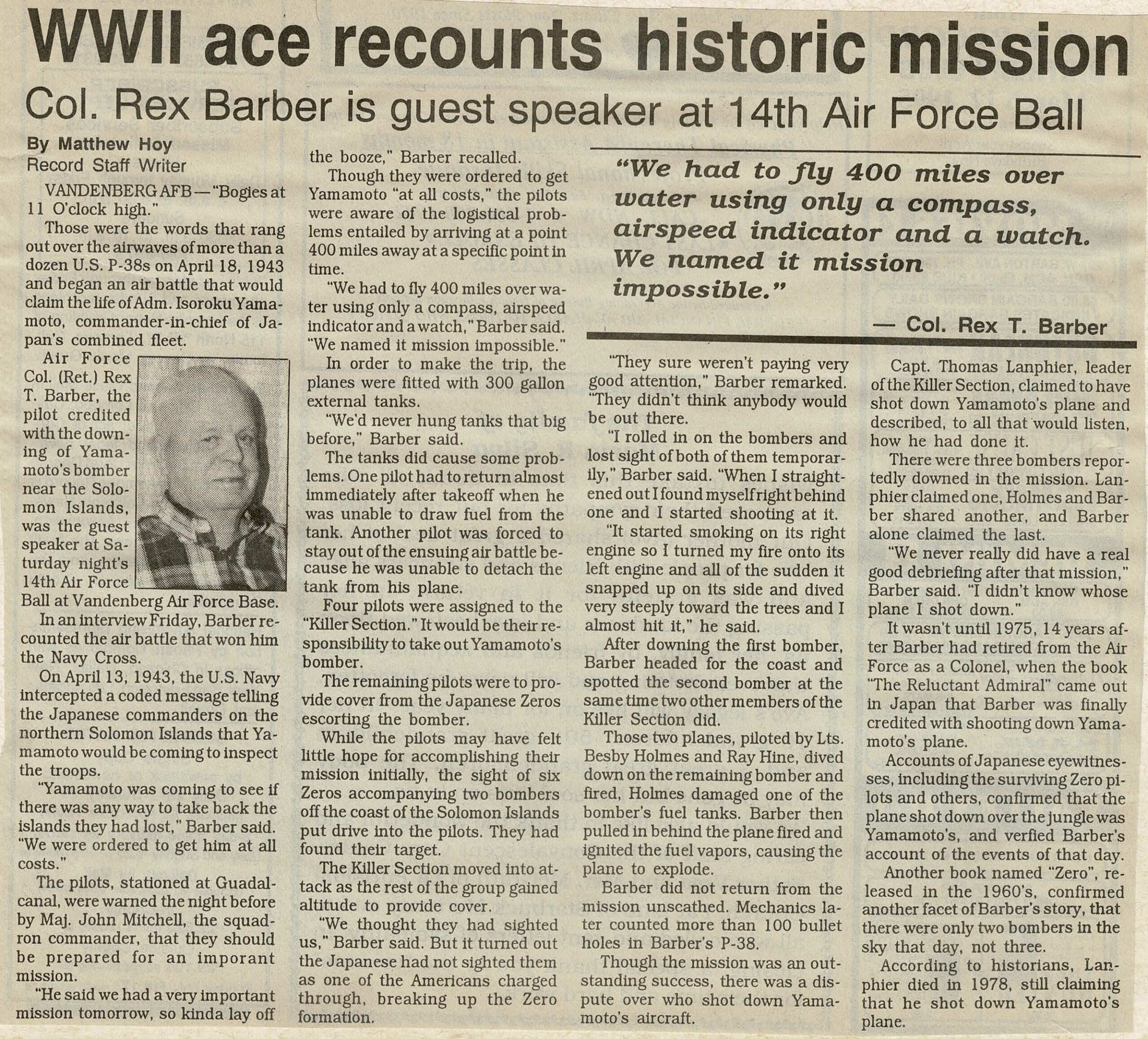Editor's note: As the son of a high school history teacher, this was one of the highlights of my reporting career. Sitting down with a man who had an enormous impact on the outcome of the War in the Pacific. I'd interviewed politicians before and others who'd distinguished themselves in one way or another, but hearing about Col. Rex Barber's aerial exploits have always stood out in my memory.
By Matthew Hoy
Record Staff Writer
VANDENBERG AFB—"Bogies at 11 O'clock high."
Those were the words that rang out over the airwaves of more than a dozen U.S. P-38s on April 18, 1943 and began an air battle that would claim the life of Adm. lsoroku Yamamoto, commander-in-chief of Japan's combined fleet.
Air Force Col. (Ret.) Rex T. Barber, the pilot credited with the downing of Yamamoto's bomber near the Solomon Islands, was the guest speaker at Saturday night's 14th Air Force Ball at Vandenberg Air Force Base.
In an interview Friday, Barber recounted the air battle that won him the Navy Cross.
On April 13, 1943, the U.S. Navy intercepted a coded message telling the Japanese commanders on the northern Solomon Islands that Yamamoto would be coming to inspect the troops.
"Yamamoto was coming to see if there was any way to take back the islands they had lost," Barber said. "We were ordered to get him at all costs."
The pilots, stationed at Guadalcanal, were warned the night before by Maj. John Mitchell, the squadron commander, that they should be prepared for an important mission.
"He said we had a very important mission tomorrow, so kinda lay off the booze," Barber recalled.
Though they were ordered to get Yamamoto "at all costs," the pilots were aware of the logistical problems entailed by arriving at a point 400 miles away at a specific point in time.
"We had to fly 400 miles over water using only a compass, airspeed indicator and a watch," Barber said. "We named it mission impossible."
In order to make the trip, the planes were fitted with 300-gallon external tanks.
"We'd never hung tanks that big before," Barber said.
The tanks did cause some problems. One pilot had to return almost immediately after takeoff when he was unable to draw fuel from the tank. Another pilot was forced to stay out of the ensuing air battle because he was unable to detach the tank from his plane.
Four pilots were assigned to the "Killer Section." It would be their responsibility to take out Yamamoto's bomber.
The remaining pilots were to provide cover from the Japanese Zeros escorting the bomber.
While the pilots may have felt little hope for accomplishing their mission initially, the sight of six Zeros accompanying two bombers
off the coast of the Solomon Islands put drive into the pilots. They had found their target.
The Killer Section moved into attack as the rest of the group gained altitude to provide cover.
"We thought they had sighted us," Barber said. But it turned out the Japanese had not sighted them as one of the Americans charged
through, breaking up the Zero formation.
"They sure weren't paying very good attention," Barber remarked. "They didn't think anybody would be out there.
"I rolled in on the bombers and lost sight of both of them temporarily," Barber said. "When I straightened out I found myself right behind one and I started shooting at it.
"It started smoking on its right engine so I turned my fire onto its left engine and all of the sudden it snapped up on its side and dived very steeply toward the trees and I almost hit it," he said.
After downing the first bomber, Barber headed for the coast and spotted the second bomber at the same time two other members of the Killer Section did.
Those two planes, piloted by Lts. Besby Holmes and Ray Hine, dived down on the remaining bomber and fired, Holmes damaged one of the bomber's fuel tanks. Barber then pulled in behind the plane, fired and ignited the fuel vapors, causing the plane to explode.
Barber did not return from the mission unscathed. Mechanics later counted more than 100 bullet holes in Barber's P-38.
Though the mission was an outstanding success, there was a dispute over who shot down Yamamoto's aircraft.\
Capt. Thomas Lanphier, leader of the Killer Section, claimed to have shot down Yamamoto's plane and described, to all that would listen, how he had done it.
There were three bombers reportedly downed in the mission. Lanphier claimed one, Holmes and Barber shared another, and Barber
alone claimed the last.
"We never really did have a real good debriefing after that mission," Barber said. "I didn't know whose plane I shot down."
It wasn't until 1975, 14 years after Barber had retired from the Air Force as a Colonel, when the book "The Reluctant Admiral" came out in Japan that Barber was finally credited with shooting down Yamamoto's plane.
Accounts of Japanese eyewitnesses, including the surviving Zero pilots and others, confirmed that the plane shot down over the jungle was Yamamoto's, and verified Barber's account of the events of that day.
Another book named "Zero", released in the l 960's, confirmed another facet of Barber's story, that there were only two bombers in the sky that day, not three. According to historians, Lanphier died in 1978, still claiming that he shot down Yamamoto's plane.
Published Sunday, March 12, 1995 in The Lompoc Record.
